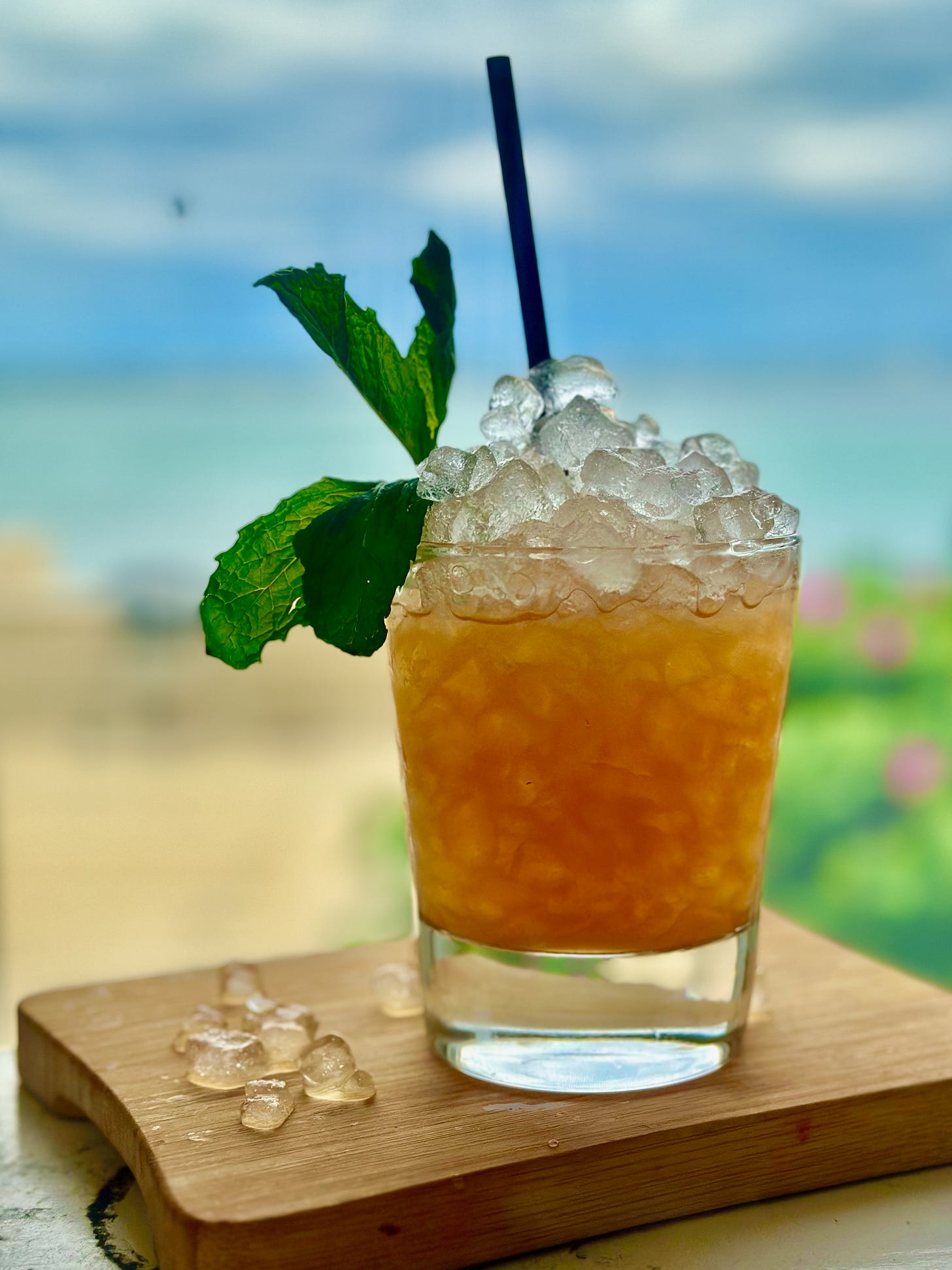Have a Smashing Summer With a Whiskey Smash
Add muddled fruit to your Mint Julep for a refreshing summer sipper.
Over the last few weeks, we have looked at various raspberry cocktails, as well as a modded, sage-inflected mezcal julep.
These drinks might not seem like they have much in common, but the connecting thread is that they use herbs and fresh fruit to flavor cocktails. They’re what you might think of as produce-section drinks, or perhaps farmers market cocktails. They expand the possibilities of various cocktail formats by adding herbs and produce to the mix.
This year, as summer nears and Memorial Day weekend arrives, I want to encourage you to make another produce section/farmers' market cocktail: the Whiskey Smash.
In the past, I have argued that summer drinking is defined by the Daiquiri and the Margarita. I still believe that’s true.
But not everyone loves rum, and while I actually think that pretty much everyone who likes boozy mixed drinks of any kind can appreciate a well-made Margarita, there’s room for other types of drinks too. And whiskey drinkers, in particular, are often underserved by the usual array of light, sweet, juicy summer drinks.
The Whiskey Smash solves that problem. It’s sort of a Mint Julep and sort of a minty Whiskey Sour. However you want to categorize it, it’s fresh, easy to make with basic ingredients, and perfectly delicious on a warm summer evening. Try one. It will make your summer a smash.
Hulk Smash
The earliest smashes were probably served in the 1830s. But a recipe for the drink first appeared in Jerry Thomas’s groundbreaking 1860s bar manual, The Bartender’s Guide.
Thomas’ recipe for a smash looked an awful lot like a Mint Julep, with whiskey, sugar, and mint. Indeed, aside from the proportions, it’s rather hard to tell the difference between the two. When it was first recorded, a Whiskey Smash was just a Mint Julep by another name.
But just because one bartender records a drink recipe in a particular way doesn’t mean that future bartenders—or home cocktail enthusiasts—will actually follow the recipe exactly as printed.
Trust me on this: As someone who writes about cocktail recipes, I am well aware that you, dear readers, are modding, swapping, and otherwise adapting the drinks in this newsletter. (One thing that makes this newsletter a little different from some other food-and-drink guides is that I’m quite happy to see those swaps, substitutions, and modifications.)
That tendency to modify and adapt was true in the heyday of pre-Prohibition bartending as well. Flash—smash?—forward to a few decades after Thomas published his spec for the smash, and you’ll find another bartender, Harry Johnson, instructing bartenders to add fresh fruit to the format, giving it seasonal freshness.
Today’s smashes, however, originate primarily with another bartender, the great Dale DeGroff, whose storied tenure at New York’s Rainbow Room starting in the 1980s helped make him one of the most important figures in the early cocktail renaissance, years before anyone even realized that there was such a thing happening.
To craft the drinks for the Rainbow Room, DeGroff studied Jerry Thomas—indeed, his study of Thomas helped rescue Thomas from obscurity—and his Whiskey Smash was a simple variation on the original Julep-esque formula: to the mint, sugar, and whiskey, he added lemon wedges, which he muddled into the drink before shaking it and pouring it over crushed ice.
(We’ll Do the Smash) We’ll Do the Mooooonster Smash
Muddling those ingredients together releases some of the lemon juice contained in the wedges, transforming the drink into a sort of minty Whiskey Sour. But the use of muddled wedges, rather than fresh-squeezed juice, also helped extract lemon oil from the lemon peels, giving the drink a slight aromatic bitterness that a basic sour lacks.
Many of you have made Philadelphia Fish House Punch, another excellent summer cocktail and perhaps the greatest of all large-format boozy drinks.1
Fish House Punch starts with the making of something called oleo saccharum—a mix of lemon peels and sugar that sits for a few hours, allowing the sugar to draw out the oils from the outer skin of the fruit. The lemon oil-sugar from the oleo saccharum is a big part of what gives Fish House Punch its specific flavor.
Muddling lemons with sugar (and mint and whiskey), as DeGroff did with his Whiskey Smash, is a little like making an instant, single-serve oleo saccharum, and it imparts a similar bitter oil complexity to this drink.
To this formula, I recommend adding a dash or two of Angostura Aromatic bitters, which further grounds the drink in spice-rack complexity, a little like the bitters in the Fitzgerald (which is also, incidentally, a Dale DeGroff drink).
You can, of course, modify this structure even further, just as Johnson and DeGroff did. Johnson’s instruction was merely to add “fruit in season” to the mix. Perhaps you could add some raspberries? After all, you’re probably not using enough. What about alternative base spirits? Could there be a version with Cynar? But I’m getting ahead of myself.
We’ll look at a smash variation or two in future editions. But for now, start your summer with a Whiskey Smash.
Whiskey Smash
6-8 mint leaves
Half of a large lemon, cut into four wedges
2 dashes Angostura Aromatic bitters
¾ ounce rich (2:1) simple syrup*
2 ounces bourbon or rye, preferably Michter’s Kentucky Straight Bourbon
INSTRUCTIONS
Combine all ingredients in a cocktail shaker.
Using a muddler or wooden spoon, muddle all ingredients together. You don’t need to go overboard, but you should push and smush to the point where you can clearly smell the aromatics of the mint leaf and the lemon wedges without sticking your nose into the shaker.
Add ice to the shaker, then shake briefly to chill and integrate. (Because this is served on crushed/pebble ice, you don’t need to shake too hard or long.)
Double strain, using a cocktail strainer and a small fine mesh strainer, into a rocks glass over a mounded bed of crushed ice or pebble ice.
Garnish with an additional sprig of mint. (Not strictly necessary, but it does look nice and it emphasizes the mint aromatics.)
*Rich (2:1) simple syrup: Combine two parts white sugar with one part water, by weight, so for example 400 grams sugar and 200 grams water, in a blender. Blend on high for 2-3 minutes, until fully integrated. Bottle and store in the fridge. Keeps for a month or more.
Additional production notes:
For the whiskey, you can use bourbon or rye, though I have a slight preference for bourbon. You can use your house bourbon, whatever it is, but for the best results, I recommend Michter’s Kentucky Straight Bourbon, which gives the drink an oaky, caramel richness that plays exceptionally well with the mint, citrus, and spice.
For the lemon, try to find larger, almost orange-sized fruits. If you can only find small, lime-sized lemons, as is sometimes the case at the Washington, D.C. grocery stores I frequent, you may want to use a larger amount of lemon—say ¾ of a lemon or even a whole one.
I know some of you prefer a 1:1 simple syrup to a 2:1 “rich” syrup, in order to dial back the sweetness. That’s obviously fine as far as it goes—though remember that 2:1 syrup is 66 percent sugar and 1:1 sugar is 50 percent sugar, so the difference between the two is not that big—but if you’re looking for a slightly less sweet drink, I’d encourage you to simply dial back the syrup slightly, to something like a scant ¾ ounce or ½ ounce.
For crushed ice, I continue to recommend using a Lewis bag and wooden mallet, but you can make do with a hammer/mallet of some sort and ice folded into a towel. It’s fun to, er, smash things! For pebble/nugget ice, you can buy an expensive machine that takes up a lot of space on your counter and breaks often (this is, I am somewhat annoyed to admit, what I did) or just purchase a bag at Sonic.
For the mint, freshly picked is obviously great if you have it. But I no longer have mint growing in my yard, so I’ve been using packaged/store-bought mint from Trader Joe’s and other grocery stores. It works!
Huckleberry Smashes the Big Gal
If you have never made Fish House Punch, you should rectify this oversight as swiftly as possible. Next time you have a party, or have friends over, or attend a gathering where it’s reasonable to brink a drink, make FHP. It’s truly the greatest of all summer party punches.





This sounds so good! I know what I will be making this weekend 😀 thank you!
It sounds nice - do you have to strain this?